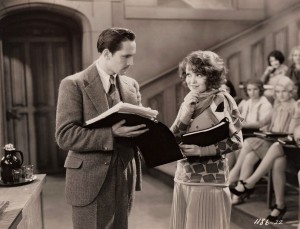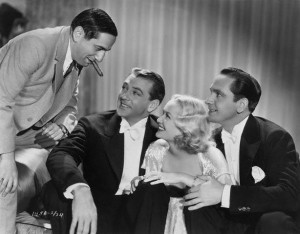Paramount Pictures: The Sophisticated Studio
Founded in 1911 (and making it the oldest American film studio still in operation), Paramount Pictures was one of the more turbulent operations in Hollywood during the pre-Code era. Beginning in the mid-1920s, the studio had begun to over-expand, growing its theater chain right before the precipitous Depression. To make matters more difficult, many of the acquisitions were done using Paramount stock; when in 1932 people were able to cash in the well priced asset, it sent Paramount’s stock price crumbling. The studio spent much of the early 30s in receivership, which lead to two very notable effects at the studio: they would gamble more on risque, controversial material in hopes of making money, and there was very little supervision in terms of what was going out the door.

Frederic March and Clara Bow in The Wild Party (1929).
It didn’t help that the transition to sound wasn’t easy for the studio. Paramount’s biggest silent star, Clara Bow, fumbled in her first few outings and went from being the biggest star in the world in 1927 to being out of pictures entirely by 1933. Others fared better, as Paramount looked to both the New York stage and the studios of Europe to find its next big stars.
Nancy Carroll, Claudette Colbert, Maurice Chevalier, Marlene Dietrich, W.C. Fields, Kay Francis, Miriam Hopkins, Carole Lombard, Jeanette MacDonald, Frederic March, the Marx Brothers, William Powell, and Charles Ruggles are just a few of the major stars assigned to the studio at this time. Several would defect (Francis and Powell were at Warner Brothers soon enough) while some, like Lombard, saw their greatest successes while being loaned out at other studios during this era. Paramount was well known in the era for its comedies, both the sophisticated sex comedies and the crazier, anarchic works.
Four directors helped guide the fortunes of the studio during this time: Cecil B. DeMille, who had been there at the inception of the studio in the early 1910s, returned to the studio in 1932 after a brief turn at MGM. His return picture, The Sign of the Cross was a sensation, setting both the audience abuzz while also inspiring a great deal of hand wringing from the country’s moral guardians. He made a few other productions at the studio including Four Frightened People, which featured a smorgasbord of flesh, before his 1934 epic Cleopatra helped cap off the era with its blatant sensuality.
Josef Von Sternberg was an Austrian director who made several silent pictures for Paramount before being invited to Europe to craft The Blue Angel as one of the continent’s first sound outings. The result was a smash, and it made a star out of Marlene Dietrich. Sternberg brought her back to the States and made five other pictures with her at Paramount, each filled with radiant and taboo breaking sexuality. The best remembered of these is probably Shanghai Express, a Best Picture nominee and box office triumph. The two also had a steamy off-camera affair that fizzled by the middle of the decade.

Ernst Lubitsch on the left with Gary Cooper, Miriam Hopkins, and Frederic March on the set of Design for Living (1933).
Rouben Mamoulian was an emigre whose 1929 Applause is one of the most dazzling of the early sound films. It’s use of sweeping camera movements breaks with many of its stodgy contemporaries. Also during the pre-Code era was one of the best horror pictures of the time with 1931’s Dr. Jekyll and Mr. Hyde, a deeply Freudian horror film that uses first person perspective and split screens to express the duality of its hero’s unpleasant nature. Also well remembered from this period is Love Me Tonight, one of Paramount’s many and rightfully acclaimed team-ups with Maurice Chevalier and Jeanette MacDonald.
Speaking of who, it’s impossible to review the history of Paramount without mentioning its finest (and perhaps the finest) director working in the early 1930s, Ernst Lubitsch. Lubitsch helped bring the musical comedy into its own during this period starting with The Love Parade in 1929 and moving up to 1934’s The Merry Widow. Lubitsch’s ability to add a touch of class to highly sexual romantic comedies that often called into question things like the importance of monogamy made his movies easily some of the most sophisticated and brilliant to every come out of tinsel town.
But the most important name at the studio wasn’t a director or even the studio head. The studio’s willingness to craft several star vehicles for Broadway sensation (and censor’s headache) Mae West turned out to be both canny and yet utterly destructive. Her two starring movies at the studio in the pre-Code era, She Done Him Wrong and I’m No Angel were major moneymakers, with She Done Him even warranting a Best Picture nomination. West, showing off her many trademarked euphemisms, became a sensation, as well as an unsurprising focal point for establishing strict film censorship.
From looking at its continental sensibilities, its of little surprise that Paramount tied Warner Brothers for the largest number of Production Code violations through the early 30s. The studios success with West’s films as well as the popularity of rising star Bing Crosby, however, helped put the studio back in the black. The studio’s fortunes would increase in the late 30s and through the boom of the postwar years. Paramount’s successes in the 1970s included movies like The Godfather and Love Story, and their winning streak continues to this day.
Paramount’s Defining Films of the Era
- The Love Parade (1929) – Ernst Lubitsch’s first talkie and Best Picture nominee.
- Skippy (1931) – Best Picture nominee.
- The Smiling Lieutenant (1931) – Another Best Picture nominee.
- Dr. Jekyll and Mr. Hyde (1932) – Stylish horror film that won Frederic March a Best Actor Oscar.
- Shanghai Express (1932) – Highest grossing film of 1932.
- One Hour With You (1932) – Another Best Picture nominee from Lubitsch.
- I’m No Angel (1933) – Mae West’s first starring Paramount picture. Highest grossing film of 1933.
- A Farewell to Arms (1933) – Frank Borzage’s Hemingway adaptation was nominated for Best Picture.
- Island of Lost Souls (1933) – Another Paramount horror film.
- She Done Him Wrong (1933) – Mae West’s second starring Paramount film. Nominated for Best Picture. No, seriously.
- The Sign of the Cross (1933) – Cecil B. DeMille’s Biblical tale that’s often counted among the reasons for the Code crackdown in 1934.
- The Story of Temple Drake (1933) – Controversial adaptation of William Faulkner’s Sanctuary. Often counted as one of the major reasons for the Code crackdown in 1934.
- Duck Soup (1933) – Last Marx Brothers picture for Paramount.
- Cleopatra (1934) – Cecil B. DeMille film and Best Picture nominee.
Notes and Availability
- Due to a deal back in 1957, a majority of Paramount Pictures from this era are actually owned by Universal. Some that
 |
 |
 |
 |
 |
| Fox | MGM | Paramount | RKO | Warners |
 |
 |
 |
||
| Columbia | Universal | United Artists | ||
| Studios Main Page | Home Page | ||||